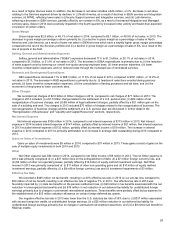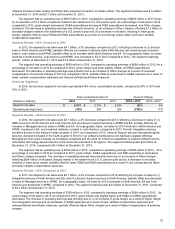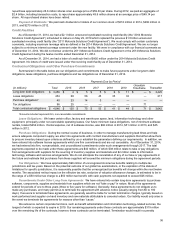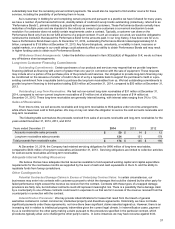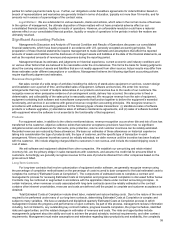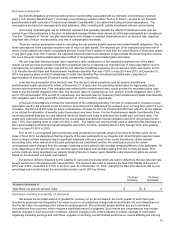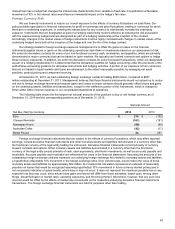Motorola 2014 Annual Report Download - page 40
Download and view the complete annual report
Please find page 40 of the 2014 Motorola annual report below. You can navigate through the pages in the report by either clicking on the pages listed below, or by using the keyword search tool below to find specific information within the annual report.38
parties for certain payments made by us. Further, our obligations under divestiture agreements for indemnification based on
breach of representations and warranties are generally limited in terms of duration, typically not more than 18 months, and for
amounts not in excess of a percentage of the contract value.
Legal Matters: We are a defendant in various lawsuits, claims and actions, which arise in the normal course of business.
In the opinion of management, the ultimate disposition of these matters will not have a material adverse effect on our
consolidated financial position, liquidity or results of operations. However, an unfavorable resolution could have a material
adverse effect on our consolidated financial position, liquidity or results of operations in the periods in which the matters are
ultimately resolved.
Significant Accounting Policies
Management’s Discussion and Analysis of Financial Condition and Results of Operations discusses our consolidated
financial statements, which have been prepared in accordance with U.S. generally accepted accounting principles. The
preparation of these financial statements requires management to make estimates and assumptions that affect the reported
amounts of assets and liabilities and the disclosure of contingent assets and liabilities at the date of the financial statements, as
well as the reported amounts of revenues and expenses during the reporting period.
Management bases its estimates and judgments on historical experience, current economic and industry conditions and
on various other factors that are believed to be reasonable under the circumstances. This forms the basis for making judgments
about the carrying values of assets and liabilities that are not readily apparent from other sources. Actual results may differ from
these estimates under different assumptions or conditions. Management believes the following significant accounting policies
require significant judgment and estimates.
Revenue Recognition
Net sales consist of a wide range of activities including the delivery of stand-alone equipment or services, custom design
and installation over a period of time, and bundled sales of equipment, software and services. We enter into revenue
arrangements that may consist of multiple deliverables of our products and services due to the needs of our customers. We
recognize revenue when persuasive evidence of an arrangement exists, delivery has occurred, the sales price is fixed or
determinable, and collectability of the sales price is reasonably assured. We recognize revenue from the sale of equipment,
equipment containing both software and nonsoftware components that function together to deliver the equipment’s essential
functionality, and services in accordance with general revenue recognition accounting principles. We recognize revenue in
accordance with software accounting guidance for the following types of sales transactions: (i) standalone sales of software
products or software upgrades, (ii) standalone sales of software maintenance agreements, and (iii) sales of software bundled
with equipment where the software is not essential to the functionality of that equipment.
Products
For equipment sales, in addition to the criteria mentioned above, revenue recognition occurs when title and risk of loss has
transferred to the customer, objective evidence exists that customer acceptance provisions have been met, no significant
obligations remain and allowances for discounts, price protection, returns and customer incentives can be reliably estimated.
Recorded revenues are reduced by these allowances. We base our estimates of these allowances on historical experience
taking into consideration the type of products sold, the type of customer, and the specific type of transaction in each
arrangement. Where customer incentives cannot be reliably estimated, we defer revenue until the incentive has been finalized
with the customer. We include shipping charges billed to customers in net revenue, and include the related shipping costs in
cost of sales.
We sell software and equipment obtained from other companies. We establish our own pricing and retain related
inventory risk, are the primary obligor in sales transactions with customers, and assume the credit risk for amounts billed to
customers. Accordingly, we generally recognize revenue for the sale of products obtained from other companies based on the
gross amount billed.
Long-Term Contracts
For long-term contracts that involve customization of equipment and/or software, we generally recognize revenue using
the percentage of completion method based on the percentage of costs incurred to date compared to the total estimated costs to
complete the contract (“Estimated Costs at Completion”). The components of estimated costs to complete a contract and
management’s process for reviewing Estimated Costs at Completion and progress toward completion is discussed further below.
Contracts may be combined or segmented in accordance with the applicable criteria under contract accounting principles. In
certain instances, when revenues or costs associated with long-term contracts cannot be reliably estimated or the contract
contains other inherent uncertainties, revenues and costs are deferred until the project is complete and customer acceptance is
obtained.
Total Estimated Costs at Completion include direct labor, material and subcontracting costs. Due to the nature of the work
required to be performed under many of our long-term contracts, determining Estimated Costs at Completion is complex and
subject to many variables. We have a standard and disciplined quarterly Estimated Costs at Completion process in which
management reviews the progress and performance of open contracts. As part of this process, management reviews information
including, but not limited to, any outstanding key contract matters, progress towards completion, the project schedule, identified
risks and opportunities, and the related changes in estimates of revenues and costs. The risks and opportunities include
management's judgment about the ability and cost to achieve the project schedule, technical requirements, and other contract
requirements. Management must make assumptions and estimates regarding labor productivity and availability, the complexity



